孟鲁司特钠咀嚼片USP-PF
孟鲁司特钠咀嚼片的副作用
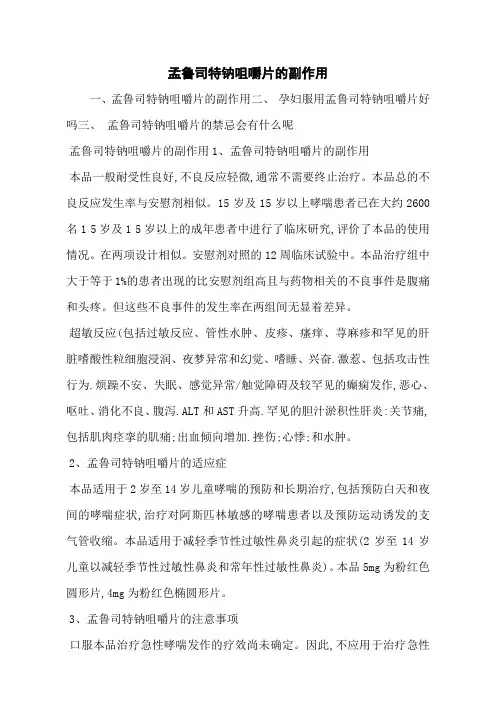
孟鲁司特钠咀嚼片的副作用
一、孟鲁司特钠咀嚼片的副作用二、孕妇服用孟鲁司特钠咀嚼片好吗三、孟鲁司特钠咀嚼片的禁忌会有什么呢
孟鲁司特钠咀嚼片的副作用1、孟鲁司特钠咀嚼片的副作用
本品一般耐受性良好,不良反应轻微,通常不需要终止治疗。
本品总的不良反应发生率与安慰剂相似。
15岁及15岁以上哮喘患者已在大约2600名1 5岁及1 5岁以上的成年患者中进行了临床研究,评价了本品的使用情况。
在两项设计相似。
安慰剂对照的12周临床试验中。
本品治疗组中大于等于1%的患者出现的比安慰剂组高且与药物相关的不良事件是腹痛和头疼。
但这些不良事件的发生率在两组间无显着差异。
超敏反应(包括过敏反应、管性水肿、皮疹、瘙痒、荨麻疹和罕见的肝脏嗜酸性粒细胞浸润、夜梦异常和幻觉、嗜睡、兴奋.激惹、包括攻击性行为.烦躁不安、失眠、感觉异常/触觉障碍及较罕见的癫痫发作,恶心、呕吐、消化不良、腹泻.ALT和AST升高.罕见的胆汁淤积性肝炎:关节痛,包括肌肉痉挛的肌痛;出血倾向增加.挫伤;心悸;和水肿。
2、孟鲁司特钠咀嚼片的适应症
本品适用于2岁至14岁儿童哮喘的预防和长期治疗,包括预防白天和夜间的哮喘症状,治疗对阿斯匹林敏感的哮喘患者以及预防运动诱发的支气管收缩。
本品适用于减轻季节性过敏性鼻炎引起的症状(2岁至14岁儿童以减轻季节性过敏性鼻炎和常年性过敏性鼻炎)。
本品5mg为粉红色圆形片,4mg为粉红色椭圆形片。
3、孟鲁司特钠咀嚼片的注意事项
口服本品治疗急性哮喘发作的疗效尚未确定。
因此,不应用于治疗急。
孟鲁司特钠咀嚼片致肺炎患儿夜梦异常1例
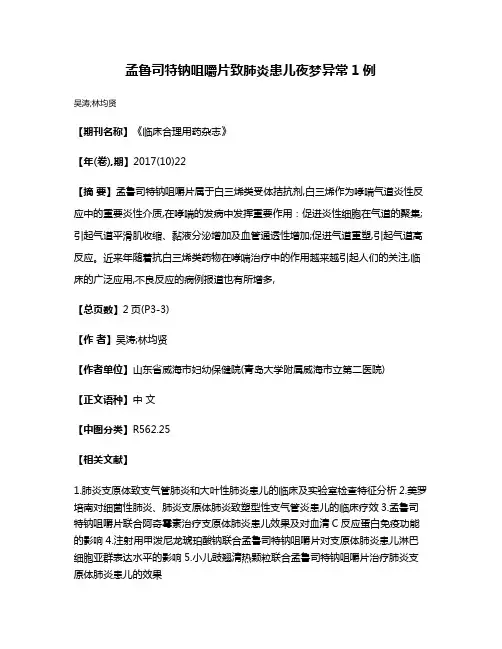
孟鲁司特钠咀嚼片致肺炎患儿夜梦异常1例
吴涛;林均贤
【期刊名称】《临床合理用药杂志》
【年(卷),期】2017(10)22
【摘要】孟鲁司特钠咀嚼片属于白三烯类受体拮抗剂,白三烯作为哮喘气道炎性反应中的重要炎性介质,在哮喘的发病中发挥重要作用:促进炎性细胞在气道的聚集;引起气道平滑肌收缩、黏液分泌增加及血管通透性增加;促进气道重塑,引起气道高反应。
近来年随着抗白三烯类药物在哮喘治疗中的作用越来越引起人们的关注,临床的广泛应用,不良反应的病例报道也有所增多,
【总页数】2页(P3-3)
【作者】吴涛;林均贤
【作者单位】山东省威海市妇幼保健院(青岛大学附属威海市立第二医院)
【正文语种】中文
【中图分类】R562.25
【相关文献】
1.肺炎支原体致支气管肺炎和大叶性肺炎患儿的临床及实验室检查特征分析
2.美罗培南对细菌性肺炎、肺炎支原体肺炎致塑型性支气管炎患儿的临床疗效
3.孟鲁司特钠咀嚼片联合阿奇霉素治疗支原体肺炎患儿效果及对血清C反应蛋白免疫功能的影响
4.注射用甲泼尼龙琥珀酸钠联合孟鲁司特钠咀嚼片对支原体肺炎患儿淋巴细胞亚群表达水平的影响
5.小儿豉翘清热颗粒联合孟鲁司特钠咀嚼片治疗肺炎支原体肺炎患儿的效果
因版权原因,仅展示原文概要,查看原文内容请购买。
孟鲁司特钠咀嚼片说明书
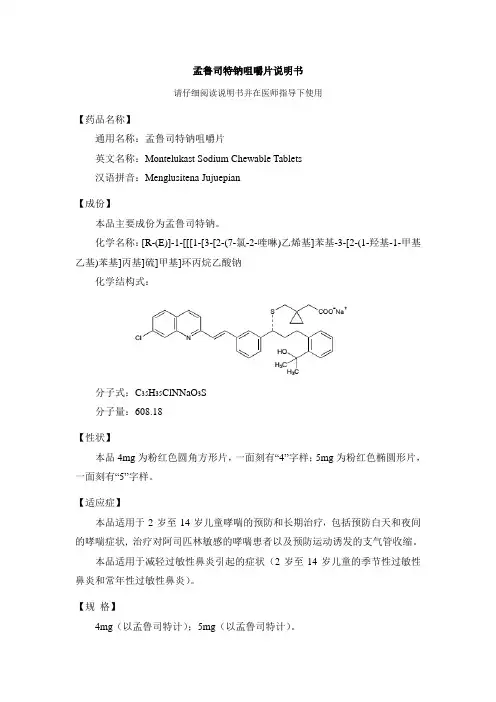
孟鲁司特钠咀嚼片说明书请仔细阅读说明书并在医师指导下使用【药品名称】通用名称:孟鲁司特钠咀嚼片英文名称:Montelukast Sodium Chewable Tablets汉语拼音:Menglusitena Jujuepian【成份】本品主要成份为孟鲁司特钠。
化学名称:[R-(E)]-1-[[[1-[3-[2-(7-氯-2-喹啉)乙烯基]苯基-3-[2-(1-羟基-1-甲基乙基)苯基]丙基]硫]甲基]环丙烷乙酸钠化学结构式:分子式:C35H35ClNNaO3S分子量:608.18【性状】本品4mg为粉红色圆角方形片,一面刻有“4”字样;5mg为粉红色椭圆形片,一面刻有“5”字样。
【适应症】本品适用于2岁至14岁儿童哮喘的预防和长期治疗包括预防白天和夜间的哮喘症状治疗对阿司匹林敏感的哮喘患者以及预防运动诱发的支气管收缩。
本品适用于减轻过敏性鼻炎引起的症状(2岁至14岁儿童的季节性过敏性鼻炎和常年性过敏性鼻炎)。
【规格】4mg(以孟鲁司特计);5mg(以孟鲁司特计)。
【用法用量】每日一次。
哮喘病人应在睡前服用。
过敏性鼻炎病人可根据自身的情况在需要时间服药。
同时患有哮喘和过敏性鼻炎的病人应每晚用药一次。
6至14岁哮喘和/或过敏性鼻炎儿童患者每日一次,每次一片(5mg)。
2至5岁哮喘和/或过敏性鼻炎儿童患者每日一次,每次一片(4mg)。
一般建议以哮喘控制指标来评价治疗效果,本品的疗效在用药一天内即出现。
本品可与食物同服或另服。
应建议患者无论在哮喘控制还是恶化阶段都坚持服用。
肾功能不全患者、轻至中度肝损害的患者及不同性别的患者无需调整剂量。
孟鲁司特钠咀嚼片与其它哮喘治疗药物的关系本品可加入患者现有的治疗方案中。
减少合并用药的剂量:支气管扩张剂单用支气管扩张剂不能有效控制的哮喘患者,可在治疗方案中加入本品,一旦有临床疗效反应(一般出现在首剂用药后),根据患者的耐受情况,可将支气管扩张剂剂量减少。
吸入糖皮质激素对接受吸入糖皮质激素治疗的哮喘患者加用本品后,可根据患者的耐受情况适当减少糖皮质激素的剂量。
孟鲁司特钠片的原理

孟鲁司特钠片的原理
孟鲁司特钠片是一种常用的降压药物,其原理主要涉及到血管
收缩和水钠平衡调节。
孟鲁司特钠是一种血管紧张素转换酶抑制剂(ACEI),它通过抑制血管紧张素转换酶的活性,阻断了血管紧张
素Ⅱ的生成。
血管紧张素Ⅱ是一种强效的血管收缩剂,它能够导致
血管收缩,增加外周阻力,使血压升高。
因此,孟鲁司特钠的作用
可以减少血管紧张素Ⅱ的生成,从而扩张血管,降低外周阻力,使
血压下降。
此外,孟鲁司特钠还能够促进一些生理活性物质如前列腺素的
生成,增加尿量,减少体液潴留,有利于水钠平衡的调节,从而也
有助于降低血压。
另外,孟鲁司特钠还能减少肾小球滤过压和肾小
管重吸收,有利于减轻肾脏的负担,对肾功能保护也有一定作用。
总的来说,孟鲁司特钠通过抑制血管紧张素Ⅱ的生成,扩张血管,减少外周阻力,促进尿量增加和水钠平衡调节,从而降低血压,保护肾功能。
这就是孟鲁司特钠片的主要原理。
值得注意的是,使
用孟鲁司特钠片时应遵医嘱,严格按照医生的建议用药,避免自行
增减剂量或者擅自停药,以免出现不良反应或者影响疗效。
孟鲁司特钠咀嚼片(顺尔宁)的说明书
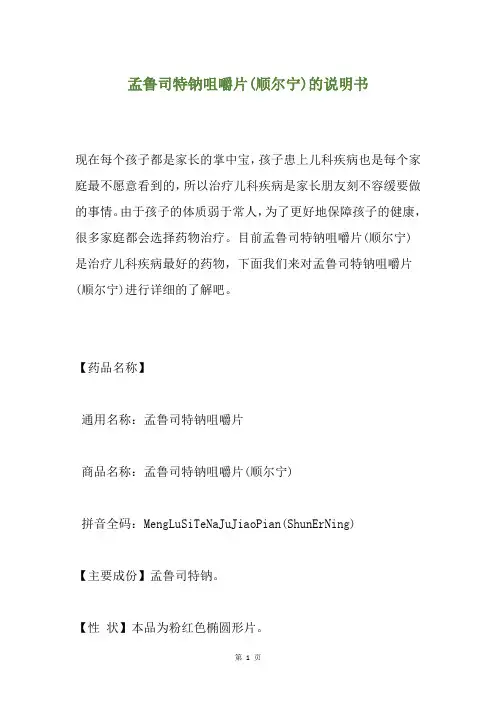
孟鲁司特钠咀嚼片(顺尔宁)的说明书现在每个孩子都是家长的掌中宝,孩子患上儿科疾病也是每个家庭最不愿意看到的,所以治疗儿科疾病是家长朋友刻不容缓要做的事情。
由于孩子的体质弱于常人,为了更好地保障孩子的健康,很多家庭都会选择药物治疗。
目前孟鲁司特钠咀嚼片(顺尔宁)是治疗儿科疾病最好的药物,下面我们来对孟鲁司特钠咀嚼片(顺尔宁)进行详细的了解吧。
【药品名称】通用名称:孟鲁司特钠咀嚼片商品名称:孟鲁司特钠咀嚼片(顺尔宁)拼音全码:MengLuSiTeNaJuJiaoPian(ShunErNing)【主要成份】孟鲁司特钠。
【性状】本品为粉红色椭圆形片。
【适应症/功能主治】本品适用于儿童哮喘的预防和长期治疗,包括预防白天和夜间的哮喘症状,治疗对阿司匹林敏感的哮喘患者以及预防运动引起的支气管收缩。
本品适用于减轻过敏性鼻炎引起的症状。
【规格型号】4mg*5s【用法用量】每日1次。
哮喘病人应在睡前服用。
季节性过敏性鼻炎可根据自身的情况在需要时间服药。
同时患有哮喘和季节性过敏性鼻炎的病人应每晚用药1次。
2-5岁哮喘和/或季节性过敏性鼻炎儿童患者每日1次,每次1片(4mg)。
一般建议:以哮喘控制指标来评价治疗效果,本品的疗效在用药一天内即出现。
本品可与食物同服或另服。
应建议患者无论在哮喘控制还是恶化阶段都坚持服用。
对肾功能不全患者、轻至中毒肝损害的患者及不同性别的患者无需调整剂量。
本品与其它哮喘治疗药物的关系:本品可加入患者现有的治疗方案中。
减少合并用药物的剂量:支气管扩张剂:单用支气管扩张剂不能有效控制的哮喘患者,可在治疗方案中加入本品,一旦有临床治疗反应(一般出现在首剂用药后),根据患者的耐受情况,可将支气管扩张剂剂量减少。
吸入糖皮质激素:对接受吸入糖皮质激素治疗的哮喘患者加用本品后,根据患者的耐受情况适当减少糖皮质激素的剂量。
应在医师指导下逐渐减量。
某些患者可逐渐减量直至完全停用吸入糖皮质激素。
但不应当用本品突然替代吸入糖皮质激素或遵医嘱。
孟鲁司特钠咀嚼片治疗小儿哮喘的临床疗效
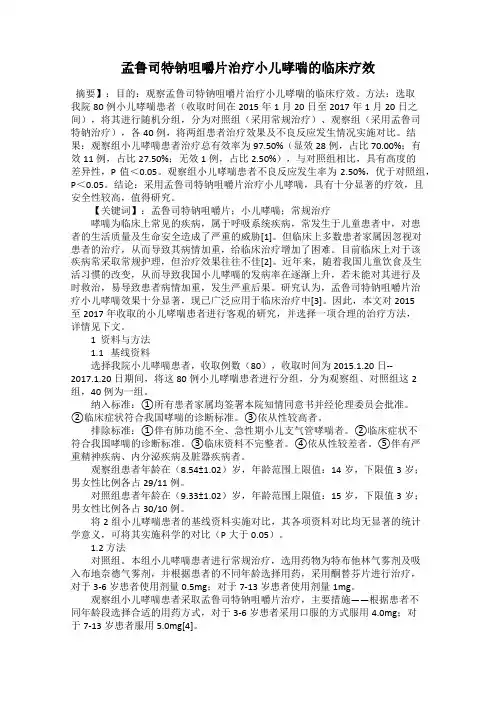
孟鲁司特钠咀嚼片治疗小儿哮喘的临床疗效摘要】:目的:观察孟鲁司特钠咀嚼片治疗小儿哮喘的临床疗效。
方法:选取我院80例小儿哮喘患者(收取时间在2015年1月20日至2017年1月20日之间),将其进行随机分组,分为对照组(采用常规治疗)、观察组(采用孟鲁司特钠治疗),各40例,将两组患者治疗效果及不良反应发生情况实施对比。
结果:观察组小儿哮喘患者治疗总有效率为97.50%(显效28例,占比70.00%;有效11例,占比27.50%;无效1例,占比2.50%),与对照组相比,具有高度的差异性,P值<0.05。
观察组小儿哮喘患者不良反应发生率为2.50%,优于对照组,P<0.05。
结论:采用孟鲁司特钠咀嚼片治疗小儿哮喘,具有十分显著的疗效,且安全性较高,值得研究。
【关键词】:孟鲁司特钠咀嚼片;小儿哮喘;常规治疗哮喘为临床上常见的疾病,属于呼吸系统疾病,常发生于儿童患者中,对患者的生活质量及生命安全造成了严重的威胁[1]。
但临床上多数患者家属因忽视对患者的治疗,从而导致其病情加重,给临床治疗增加了困难。
目前临床上对于该疾病常采取常规护理,但治疗效果往往不佳[2]。
近年来,随着我国儿童饮食及生活习惯的改变,从而导致我国小儿哮喘的发病率在逐渐上升,若未能对其进行及时救治,易导致患者病情加重,发生严重后果。
研究认为,孟鲁司特钠咀嚼片治疗小儿哮喘效果十分显著,现已广泛应用于临床治疗中[3]。
因此,本文对2015至2017年收取的小儿哮喘患者进行客观的研究,并选择一项合理的治疗方法,详情见下文。
1 资料与方法1.1 基线资料选择我院小儿哮喘患者,收取例数(80),收取时间为2015.1.20日--2017.1.20日期间,将这80例小儿哮喘患者进行分组,分为观察组、对照组这2组,40例为一组。
纳入标准:①所有患者家属均签署本院知情同意书并经伦理委员会批准。
②临床症状符合我国哮喘的诊断标准。
③依从性较高者。
排除标准:①伴有肺功能不全、急性期小儿支气管哮喘者。
孟鲁司特钠咀嚼片治疗儿童变异性咳嗽的临床效果
孟鲁司特钠咀嚼片治疗儿童变异性咳嗽的临床效果发布时间:2022-09-19T07:42:27.579Z 来源:《医师在线》2022年12期作者:戴天菊[导读] 目的:探究孟鲁司特钠咀嚼片治疗儿童变异性咳嗽的临床效果。
戴天菊云南省文山州广南县妇幼保健院 663300【摘要】目的:探究孟鲁司特钠咀嚼片治疗儿童变异性咳嗽的临床效果。
方法:对变异性咳嗽患儿观察分析,共56例,28例是对照组,28例是观察组,本调查在2020年6月开始,在2022年1月结束,治疗方式分别是常规治疗、孟鲁司特钠咀嚼片治疗,对比两组肺功能指标及临床疗效。
结果:观察组肺功能指标优于对照组(P<0.05);观察组临床疗效高于对照组(P<0.05)。
结论:变异性咳嗽患儿采用孟鲁司特钠咀嚼片进行治疗可以明显改善患儿临床症状,减少患儿治疗时间,促进肺功能恢复。
【关键词】孟鲁司特钠咀嚼片;变异性咳嗽;儿童;临床疗效变异性咳嗽是一种以慢性咳嗽为特征的呼吸内科疾病,在儿童群体中较为常见;随着环境污染日益严重,儿童患呼吸内科疾病的趋势逐年增加。
患儿早期无相关症状,仅在玩耍和运动时能感到气短,晚间尤甚;随着病情的发展,严重者会发生持续性干咳现象,最终引发哮喘,直接影响患儿精神状态,需立即进行有效治疗。
目前,临床多半采用西药进行治疗,其中孟鲁司特钠咀嚼片作为一种强效治疗气道高反应类药物[1],安全性较高,有助于改善患儿临床症状,达到治疗疾病的目的,临床效果显著。
本次研究主要分析孟鲁司特钠咀嚼片治疗儿童变异性咳嗽的临床效果,现将结果报道如下:1 资料与方法1.1一般资料对变异性咳嗽患儿观察分析,共56例,28例是对照组,28例是观察组,本调查在2020年6月开始,在2022年1月结束。
对照组,男17例,女11例,年龄最小者2岁,年龄最大者6岁,平均(4.62±0.13)岁;观察组,男13例,女15例,年龄最小者2岁,年龄最大者7岁,平均(4.97±0.25)岁。
孟鲁司特钠咀嚼片说明书_孟鲁司特钠咀嚼片
孟鲁司特钠咀嚼片说明书_孟鲁司特钠咀嚼片孟鲁司特钠咀嚼片(平奇)适用于2岁及2岁以上儿童和成人哮喘的预防和长期治疗,包括预防白天和夜间的哮喘症状,治疗对阿斯匹林敏感的哮喘患者以及预防运动诱发的支气管收缩。
下面是店铺整理的孟鲁司特钠咀嚼片说明书,欢迎阅读。
目录孟鲁司特钠咀嚼片商品介绍通用名:孟鲁司特钠咀嚼片生产厂家: 鲁南贝特制药有限公司批准文号:国药准字H20083330药品规格:5mg6片药品价格:¥40.5元孟鲁司特钠咀嚼片说明书【通用名称】孟鲁司特钠咀嚼片【商品名称】孟鲁司特钠咀嚼片(平奇)【英文名称】MontelukastSodiumChewableTablets【拼音全码】MengLuSiTeNaJuJiaoPian(PingQi)【主要成份】主要成份为孟鲁司特钠。
化学名称:[R-(E)]-1-[[[1-[3-[2-(7-氯-2-喹啉)乙烯基]苯基]-3-[2-(1-羟基-1-甲基乙基)苯基]丙基]硫]甲基]环丙烷乙酸单钠。
【性状】孟鲁司特钠咀嚼片(平奇)为片剂。
【适应症/功能主治】孟鲁司特钠咀嚼片(平奇)适用于2岁及2岁以上儿童和成人哮喘的预防和长期治疗,包括预防白天和夜间的哮喘症状,治疗对阿斯匹林敏感的哮喘患者以及预防运动诱发的支气管收缩。
【规格型号】5mg6s【用法用量】每日一次。
哮喘病人应在睡前服用。
季节性过敏性鼻炎病人可根据自身的情况在需要时服药。
同时患有哮喘和季节性过敏性鼻炎的病人应每晚用药一次。
15岁及15岁以上患有哮喘和/或季节性过敏性鼻炎的成人患者每日一次,每次10mg。
6至14岁哮喘和/或季节性过敏性鼻炎儿童患者每日一次,每次5mg。
一般建议以哮喘控制指标来评价治疗效果,孟鲁司特钠咀嚼片(平奇)的疗效在用药一天内即出现。
孟鲁司特钠咀嚼片(平奇)可与食物同服或另服。
应建议患者无论在哮喘控制还是恶化阶段都坚持服用。
【不良反应】孟鲁司特钠咀嚼片(平奇)可与其他一些常规用于哮喘预防和长期治疗及治疗季节性过敏性鼻炎的药物合用。
孟鲁司特钠咀嚼片的功效和作用
孟鲁司特钠咀嚼片的功效和作用孟鲁司特钠(Montelukast Sodium)咀嚼片是一种常用的治疗哮喘和过敏性鼻炎的药物。
它属于一种叫做白三烯受体拮抗剂的药物,通过阻断白三烯受体的结合,从而减少炎性介质的释放和气道平滑肌收缩,从而起到预防和控制哮喘和过敏性鼻炎症状的效果。
首先,孟鲁司特钠咀嚼片对于哮喘有着显著的疗效。
哮喘是一种慢性气道炎症疾病,表现为气道过敏性增高和气道平滑肌收缩,从而导致呼吸困难、咳嗽、气喘等症状。
孟鲁司特钠通过阻断白三烯受体的结合,减少炎性介质的释放,从而减轻气道炎症反应,解除气道平滑肌收缩,从而使呼吸道畅通,减少呼吸道症状的发生。
此外,孟鲁司特钠还能减少炎症细胞的浸润和活化,抑制气道高反应性。
其次,孟鲁司特钠咀嚼片对于过敏性鼻炎也有良好的疗效。
过敏性鼻炎是一种由过敏原引起的鼻黏膜炎症,表现为鼻塞、流涕、打喷嚏、鼻痒等症状。
孟鲁司特钠通过减少炎症介质的释放,抑制过敏原引起的鼻黏膜炎症,从而减轻过敏性鼻炎症状。
对于季节性过敏性鼻炎和持续性过敏性鼻炎都有显著的疗效,能够提供长期的缓解。
此外,孟鲁司特钠咀嚼片还可以用于预防运动诱发的哮喘发作。
运动诱发的哮喘是由运动引起的呼吸道狭窄和气喘,阻碍了运动能力和体育锻炼。
通过服用孟鲁司特钠咀嚼片,可以有效地减少运动诱发的哮喘发作,提高身体的运动耐受性。
总结起来,孟鲁司特钠咀嚼片是一种具有显著疗效的抗哮喘和抗过敏药物。
它通过阻断白三烯受体的结合,减少炎性介质的释放,减轻气道炎症反应和气道平滑肌收缩,从而预防和控制哮喘和过敏性鼻炎的症状。
同时,它还可以用于预防运动诱发的哮喘发作,提高运动耐受性。
然而,在使用孟鲁司特钠咀嚼片时,还是需要在医生的指导下进行,按照医生的建议进行用药,以免出现不良反应和药物相互作用。
孟鲁司特钠咀嚼片制剂学研究
整粒参数
整粒的目的是使颗粒粒度分布均 匀,控制好整粒的筛网目数和筛 网振幅等参数。
压片参数
压片时控制好压力和片重等参数, 以保证片剂的硬度和含量均匀性。
工艺验证与优化
验证方案
制定详细的工艺验证方案,包括验证目的、方法、 评价标准等。
验证结果分析
对验证数据进行统计分析,评估工艺的可行性和 可靠性。
ABCD
临床需求
针对不同疾病和患者情况,需选择合适的剂 型以满足临床需求。
市场因素
剂型选择还需考虑市场接受度和竞争情况, 以实现良好的市场表现。
03
孟鲁司特钠咀嚼片处方设计
主药成分的选择与剂量确定
主药成分
孟鲁司特钠,是一种口服的白三烯受 体拮抗剂,用于治疗哮喘和慢性阻塞 性肺病。
剂量确定
根据临床试验和文献资料,确定孟鲁 司特钠的剂量范围,以满足治疗需要 并确保安全性。
安全性分析
对使用孟鲁司特钠咀嚼片过程中出现的不良反应进行监测和分析,评估其安全性。
感谢您的观看
THANKS
用途
主要用于预防和治疗哮喘、慢性阻塞性 肺疾病(COPD)等呼吸道疾病,以及 减轻过敏性鼻炎症状。
药物发现与研发历程
孟鲁司特钠由默克公司研发,最初是作为一种新型非甾体抗炎药进行研发。
在研发过程中,科学家发现其具有强大的白三烯受体拮抗作用,因此被重新定位并开发为抗哮喘药物。
经过临床试验验证其疗效和安全性后,孟鲁司特钠于1998年获得美国食品药品监督管理局(FDA)批准 上市。
包装材料
选用符合规定的包装材料,确保 包装密封性、阻光性、防潮性等 符合要求。
质量检测方法研究
含量测定
建立准确可靠的含量测定方法,确保制剂中孟鲁司 特钠的含量符合规定。
- 1、下载文档前请自行甄别文档内容的完整性,平台不提供额外的编辑、内容补充、找答案等附加服务。
- 2、"仅部分预览"的文档,不可在线预览部分如存在完整性等问题,可反馈申请退款(可完整预览的文档不适用该条件!)。
- 3、如文档侵犯您的权益,请联系客服反馈,我们会尽快为您处理(人工客服工作时间:9:00-18:30)。
B RIEFINGMontelukast Sodium Chewable Tablets. Because there is no existing USP monograph for this dosage form, a new monograph based on validated methods of analysis is being proposed. The liquidchromatographic procedure in the Assay and the test for Organic Impurities is based on analyses performed with the Phenomenex LUNA Phenyl-hexyl brand of L11 column. The typical retention time for montelukast is about 15 min. The liquid chromatographic procedure in the test for Dissolution is based on analysesperformed with the Inertsil Phenyl brand of L11 column. The typical retention time for montelukast is about 1.8 min.(SM4: M. Koleck.)Correspondence Number—C126761Comment deadline: November 30, 2014Add the following:Montelukast Sodium Chewable TabletsDEFINITIONMontelukast Sodium Chewable Tablets contain Montelukast Sodium equivalent to NLT 93.5% and NMT 105.0% of the labeled amount of montelukast (C 35H 36ClNO 3S).[ NOTE— Avoid exposure of the samples to light. Use low-actinic glassware.]IDENTIFICATION• A. U LTRA VIOLET A BSORPTION 197UDiluent: Methanol and water (3:1)Standard solution (for 4-mg Chewable Tablets): 0.026 mg/mL of USP Montelukast Dicyclohexylamine RS in DiluentStandard solution (for 5-mg Chewable Tablets): 0.033 mg/mL of USP Montelukast Dicyclohexylamine RS in DiluentSample solution: Nominally (L /200) mg/mL of montelukast , where L is the label claim of montelukast in mg/Chewable Tablet prepared as follows. Transfer one Chewable Tablet to a suitable volumetric flask,add 25% of the flask volume of water, and let stand for 5–10 min until the Chewable Tablet has disintegrated. Add 55% of the flask volume of methanol, shake well, and sonicate for 70 min withoccasional shaking. Cool to room temperature, dilute with methanol to volume, and mix well. Centrifuge a portion of the resulting solution to obtain a clear solution.Wavelength range: 210–400 nmAcceptance criteria: The Sample solution exhibits maxima only at the same wavelengths as the Standard solution .• B. The retention time of the major peak of the Sample solution corresponds to that of the Standard solution ,as obtained in the Assay .ASSAY• P ROCEDUREDiluent: Methanol and water (3:1)Solution A: 0.2% (v/v) Trifluoroacetic acid in water Solution B: Methanol and acetonitrile (3:2)Mobile phase: See Table 1.Table 1Time (min)Solution A (%)Solution B (%)0485254555124555222575232575254852304852Standard solution: 0.33 mg/mL of USP Montelukast Dicyclohexylamine RS in DiluentSystem suitability solution: Transfer 10 mL of the Standard solution to a clear 10-mL volumetric flask, add 4 µL of hydrogen peroxide, and mix well. Expose the flask for at least 4 h to ambient light or 10 min to a 4 kLux cool white light.[ NOTE— Montelukast is partially converted to the cis-isomer under these conditions.]Sensitivity solution: 0.33 µg/mL of USP Montelukast Dicyclohexylamine RS in Diluent from the Standard solutionSample solution (for 4-mg Chewable Tablets): Nominally 0.24 mg/mL of montelukast prepared as follows. Transfer 12 Chewable Tablets to a suitable volumetric flask, add 75% of the flask volume of Diluent, and shake vigorously for 60 min. Dilute with Diluent to volume. Pass a portion of the resulting solution through a suitable filter of 0.45-µm pore size, discarding the first mL of filtrate. Use the filtrate. Sample solution (for 5-mg Chewable Tablets): Nominally 0.25 mg/mL of montelukast prepared as follows. Transfer 10 Chewable Tablets to a suitable volumetric flask, add 75% of the flask volume of Diluent, and shake vigorously for 60 min. Dilute with Diluent to volume. Pass a portion of the resulting solution through a suitable filter of 0.45-µm pore size, discarding the first mL of filtrate. Use the filtrate. Chromatographic system(See Chromatography 621, System Suitability.)Mode: LCDetector: UV 255 nmColumnsGuard: 3.0-mm × 4-mm; packing L11Analytical: 4.6-mm × 10-cm; 3-µm packing L11Column temperature: 50Flow rate: 1.5 mL/minInjection volume: 20 µLRun time: 2 times the retention time of montelukastSystem suitabilitySamples: Standard solution, System suitability solution, and Sensitivity solution[ NOTE— The relative retention times of the cis-isomer and montelukast are about 0.92 and 1.0,respectively.]Suitability requirementsResolution: NLT 1.5 between the cis-isomer and montelukast, System suitability solutionRelative standard deviation: NMT 2% for five injections, Standard solutionSignal-to-noise ratio: NLT 10, Sensitivity solutionAnalysisSamples: Standard solution and Sample solutionCalculate the percentage of the labeled amount of montelukast (C35H36ClNO3S) in the portion of Tablets taken:Result = ( r U / r S ) × ( C S / C U ) × ( M r1 / M r2 ) × 100r U= peak response from the Sample solutionr S= peak response from the Standard solutionC S= concentration of USP Montelukast Dicyclohexylamine RS in the Standard solution(mg/mL)C U= nominal concentration of montelukast in the Sample solution (mg/mL)= molecular weight of montelukast, 586.18Mr1= molecular weight of montelukast dicyclohexylamine, 767.50Mr2Acceptance criteria: 93.5%–105.0%PERFORMANCE TESTS• D ISSOLUTION711Medium: 0.5% (w/v) Sodium dodecyl sulfate in water; 900 mL. Do not deaerate.Apparatus 2: 50 rpmTime: 20 minSolution A: 0.2% (v/v) Trifluoroacetic acid in waterSolution B: 0.2% (v/v) Trifluoroacetic acid in acetonitrileMobile phase: Solution A and Solution B (1:1)Standard stock solution (for 4-mg Chewable Tablets): 0.30 mg/mL of USP MontelukastDicyclohexylamine RS in methanol (equivalent to 0.23 mg/mL of montelukast)Standard stock solution (for 5-mg Chewable Tablets): 0.35 mg/mL of USP MontelukastDicyclohexylamine RS in methanol (equivalent to 0.27 mg/mL of montelukast)Standard solution: (L/900) mg/mL of montelukast in Medium from the Standard stock solution, where L is the label claim in mg/Chewable Tablet of montelukastSample solution: Pass a portion of the solution under test through a suitable filter or centrifuge to obtain a clear solution.Chromatographic system(See Chromatography 621, System Suitability.)Mode: LCDetector: UV 389 nmColumn: 3.0-mm × 10-cm; 5-µm packing L11Column temperature: 50Flow rate: 0.9 mL/minInjection volume: 50 µLRun time: 1.5 times the retention time of montelukastSystem suitabilitySample: Standard solutionSuitability requirementsTailing factor: NMT 1.5Relative standard deviation: NMT 2%AnalysisSamples: Standard solution and Sample solutionCalculate the percentage of the labeled amount of montelukast (C35H36ClNO3S) dissolved:Result = ( r U / r S ) × C S × V × (1/L) × 100r U= peak response from the Sample solutionr S= peak response from the Standard solutionC S= concentration of montelukast in the Standard solution (mg/mL)V= volume of Medium (900 mL)L= label claim (mg/Chewable Tablet)Tolerances: NLT 80% (Q) of the labeled amount of montelukast (C35H36ClNO3S) is dissolved• U NIFORMITY OF D OSA GE U NITS905Procedure for content uniformitySolution A, Solution B, Mobile phase, and System suitability: Proceed as directed in Dissolution.Diluent: Methanol and water (3:1)Standard solution (for 4-mg Chewable Tablets): 0.026 mg/mL of USP Montelukast Dicyclohexylamine RS in DiluentStandard solution (for 5-mg Chewable Tablets): 0.033 mg/mL of USP Montelukast Dicyclohexylamine RS in DiluentSample solution: Nominally (L/200) mg/mL of montelukast, where L is the label claim of montelukast in mg/Chewable Tablet prepared as follows. Transfer one Chewable Tablet to a suitable volumetric flask, add 25% of the flask volume of water, and let stand for 5–10 min until the Chewable Tablet has disintegrated. Add 55% of the flask volume of methanol, shake well, and sonicate for 70 min with occasional shaking. Cool to room temperature, dilute with methanol to volume, and mix well. Passa portion of the resulting solution through a suitable filter or centrifuge to obtain a clear solution.Chromatographic system: Proceed as directed in Dissolution, except use an Injection volume of 10 µL.AnalysisSamples: Standard solution and Sample solutionCalculate the percentage of the labeled amount of montelukast (C35H36ClNO3S) in the ChewableTablet taken:Result = ( r U / r S ) × ( C S / C U ) × ( M r1 / M r2 ) × 100r U= peak response from the Sample solutionr S= peak response from the Standard solutionC S= concentration of USP Montelukast Dicyclohexylamine RS in the Standardsolution (mg/mL)C U= nominal concentration of montelukast in the Sample solution (mg/mL)= molecular weight of montelukast, 586.18Mr1= molecular weight of montelukast dicyclohexylamine, 767.50Mr2Acceptance criteria: Meet the requirementsIMPURITIES• O RGA NIC I MPURITIESDiluent, Solution A, Solution B, Mobile phase, Standard solution, System suitability solution, Sensitivity solution, Sample solution, Chromatographic system, and System suitability: Proceed as directed in the Assay.AnalysisSamples: Standard solution and Sample solutionCalculate the percentage of any individual degradation product in the portion of Chewable Tablets taken: Result = ( r U / r S ) × ( C S / C U ) × ( M r1 / M r2 ) × (1/F) × 100 r U= peak response of any individual degradation product from the Sample solutionr S= peak response of montelukast from the Standard solutionC S= concentration of USP Montelukast Dicyclohexylamine RS in the Standard solution(mg/mL)C U= nominal concentration of montelukast in the Sample solution (mg/mL)= molecular weight of montelukast, 586.18Mr1= molecular weight of montelukast dicyclohexylamine, 767.50Mr2F= relative response factor (see Table 2)Acceptance criteria: See Table 2. Disregard any peak with an area less than that of the Sensitivity solution.Table 2Name RelativeRetentionTimeRelativeResponseFactorAcceptanceCriteria,NMT (%)Sulfoxide impurity a,b0.45 1.0 1.5 Montelukast ketone impurity c0.71 1.70.2 cis-Isomer d0.92 1.00.2 Montelukast 1.0——Methylketone impurity e,f 1.04——Michael Adduct 1g,e 1.16——Michael Adduct 2h,e 1.18——Methylstyrene impurity i,e 1.55——Any other individual degradation product— 1.00.2 Total impurities—— 2.0a These two impurities are not resolved by the method and need to be integratedtogether to determine conformance.b [1-[[[1-[3-[(E)-2-(7-Chloroquinolin-2-yl)ethenyl]phenyl]-3-[2-(1-hydroxy-1-methylethyl)phenyl]propyl]sulfinyl]methyl]cyclopropyl]acetic acid.c (E)-1-{3-[2-(7-Chloroquinolin-2-yl)vinyl]phenyl}-3-[2-(2-hydroxypropan-2-yl)phenyl]propan-1-one.d [1-[[[(1R )-1-[3-[(Z)-2-(7-Chloroquinolin-2-yl)ethenyl]phenyl]-3-[2-(1-hydroxy-1-methylethyl)phenyl]propyl]sulfanyl]methyl]cyclopropyl]acetic acid.e This is a process impurity and is included in the table for identification only. Thisimpurity is controlled in the drug substance. It is not to be reported for the drug product and should not be included in the total impurities.f [1-[[[(1R )-3-(2-Acetylphenyl)-1-[3-[(E)-2-(7-chloroquinolin-2-yl)ethenyl]phenyl]propyl]sulfanyl]methyl]cyclopropyl]acetic acid.g 1-[[[(1R )-1-[3-[(1R )-1-[[[1-(Carboxymethyl)cyclopropyl]methyl]sulfanyl]-2-(7-chloroquinolin-2-yl)ethyl]phenyl]-3-[2-(1-hydroxy-1-methylethyl)phenyl]propyl]sulfanyl]methyl]cyclopropyl]acetic acid.h 1-[[[(1R )-1-[3-[(1S )-1-[[[1-(Carboxymethyl)cyclopropyl]methyl]sulfanyl]-2-(7-chloroquinolin-2-yl)ethyl]phenyl]-3-[2-(1-hydroxy-1-methylethyl)phenyl]propyl]sulfanyl]methyl]cyclopropyl]acetic acid.i [1-[[[(1R )-1-[3-[(E)-2-(7-Chloroquinolin-2-yl)ethenyl]phenyl]-3-[2-(1-methylethenyl)phenyl]propyl]sulfanyl]methyl]cyclopropyl]acetic acid.ADDITIONAL REQUIREMENTS• P A CKA GING A ND S TORA GE: Preserve in tight containers, protected from light. Store at controlled room temperature.• USP R EFERENCE S TA NDA RDS11USP Montelukast Dicyclohexylamine RSC35H36ClNO3S · C12H23N 767.502S (USP38)Auxiliary Information - Please check for your question in the FAQs before contacting USP.。
